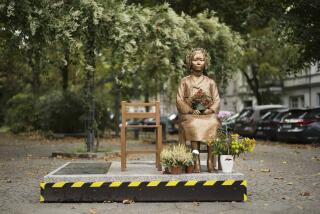Weinberger Sees Major’s Widow, Assails Soviets
- Share via
WEST BERLIN — In a white-washed building that once housed offices of Germany’s World War II Luftwaffe, Defense Secretary Caspar W. Weinberger met Tuesday with the widow of slain U.S. Army Maj. Arthur D. Nicholson Jr. and told her that the Soviets “simply don’t respond in a way that civilized people do.”
Weinberger spent 6 1/2 hours in this divided city--his first visit here as secretary. To the dismay of some U.S. officials, he kept alive the public attack he has led since Nicholson was shot by a Soviet sentry on March 24 while on liaison duty in East Germany.
Nicholson’s widow, Karen, thanked Weinberger for his continuing insistence that the Soviet Union apologize and compensate her and her 8-year-old daughter, and she offered what U.S. officials said was her first public comment on the shooting.
“I think it’s very special that someone sort of took up the family position and asked for compensation. I think it’s very good to keep reminding them of it,” she said. “I don’t think that Nick should have just died and been forgotten.”
Assistance Barred
Her unarmed husband was shot by a Soviet soldier while attempting to photograph a Soviet tank training area. After the shooting, Soviet units prohibited a U.S. sergeant who accompanied Nicholson from assisting the dying officer and refused to give any medical aid themselves.
The continuing focus on Nicholson has annoyed some officials in the State Department, and one American diplomat made it clear Tuesday that the demands for an apology and compensation were making life difficult for him in his routine dealings with the Soviets in Berlin.
“We’ve got to live with these guys,” he said.
One of those whose official duties involve some of the most frequent contacts with the Soviets in East Germany, Col. Roland Lajoie, head of the Military Liaison Mission to which Nicholson was assigned, has studiously avoided public discussion of the incident, only to be ordered by military superiors to brief reporters Tuesday about the mission’s duties.
Uncomfortable Position
“Nobody was more mortified than Lajoie” when he found he would be contributing to the public dialogue, said the American diplomat, who spoke on the understanding that he would not be identified by name.
But, Weinberger, told that his continued focus on the shooting is irksome to some officials, said later on his way to Brussels for a North Atlantic Treaty Organization meeting: “We expect to keep raising it. I hope they (the Soviets) will recognize their culpability and change their behavior.”
In West Berlin, when he was asked about the U.S. response to the shooting of Nicholson, the secretary told a group of about 150 American soldiers:
“We don’t plan to shoot every Russian sentry we see. That’s what they do. It was a coldblooded murder and, worse than that, you know better than anybody, they accompanied it by preventing any kind of medical assistance from reaching him while he was dying on the ground. It was a totally reprehensible, barbaric type of act.”
Weinberger’s visit to West Berlin, whose approximately 2 million residents live 110 miles inside East Germany, was designed as a morale-builder for the 7,000 U.S. troops stationed here and, in particular, for the 14-member liaison team.
Cat-and-Mouse Game
The group’s official role is to serve as the U.S. contact with the 380,000 Soviet soldiers in East Germany. But, unofficially, the American team and a similar Soviet unit stationed in West Germany play a cat-and-mouse game, keeping tabs on each sides’ military movements and equipment.
Asked about the morale of his unit, Lajoie said: “It’s OK. Obviously, when you lose an officer that everybody knows in a small organization, there’s an emotional impact. We’re now back to functioning normally.”
Another senior officer said the American troops in West Berlin have expressed anguish. He added, “A young man might feel we ought to do something.” But he added, “I don’t think there’s any feeling in the Berlin brigade that we should have gone across the (Berlin) Wall.”
More to Read
Sign up for Essential California
The most important California stories and recommendations in your inbox every morning.
You may occasionally receive promotional content from the Los Angeles Times.










